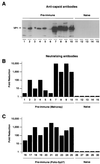Preexisting immunity to poliovirus does not impair the efficacy of recombinant poliovirus vaccine vectors
- PMID: 11134275
- PMCID: PMC113958
- DOI: 10.1128/JVI.75.2.622-627.2001
Preexisting immunity to poliovirus does not impair the efficacy of recombinant poliovirus vaccine vectors
Abstract
Recombinant viruses are attractive candidates for the development of novel vaccines. A number of viruses have been engineered as vaccine vectors to express antigens from other pathogens or tumors. Inoculation of susceptible animals with this type of recombinant virus results in the induction of both humoral and cellular immune responses directed against the foreign antigens. A general problem to this approach is that existing immunity to the vector can diminish or completely abolish the efficacy of the viral vector. In this study, we investigated whether poliovirus recombinants are capable of inducing effective immunity to the foreign antigen in previously vaccinated animals. Antipoliovirus immunity was induced in susceptible mice by intraperitoneal immunization with live poliovirus. Immunized mice developed antibodies directed against capsid proteins that effectively neutralized poliovirus in vitro and protected animals from a lethal challenge with a high dose of pathogenic poliovirus. To test whether preexisting immunity reduces the efficacy of vaccination with recombinant poliovirus, immunized mice were inoculated with a recombinant poliovirus expressing the C-terminal half of chicken ovalbumin (Polio-Ova). Animals developed ovalbumin-specific antibodies and cytotoxic T lymphocytes (CTL). While the antibody titers observed in preimmune and naive mice were similar, the overall CTL response appeared to be reduced in preimmune mice. Importantly, vaccination with Polio-Ova was able to effectively protect preimmune mice against lethal challenge with a tumor expressing the antigen. Thus, preexisting immunity to poliovirus does not compromise seriously the efficacy of replication-competent poliovirus vaccine vectors. These results contrast with those observed for other viral vaccine vectors and suggest that preexisting immunity does not equally affect the vaccine potential of individual viral vectors.
Figures



Similar articles
-
Poliovirus vaccine vectors elicit antigen-specific cytotoxic T cells and protect mice against lethal challenge with malignant melanoma cells expressing a model antigen.Proc Natl Acad Sci U S A. 1998 Jul 7;95(14):8216-21. doi: 10.1073/pnas.95.14.8216. Proc Natl Acad Sci U S A. 1998. PMID: 9653167 Free PMC article.
-
Comparative Evaluation of the Vaccine Efficacies of Three Adenovirus-Based Vector Types in the Friend Retrovirus Infection Model.J Virol. 2019 Oct 15;93(21):e01155-19. doi: 10.1128/JVI.01155-19. Print 2019 Nov 1. J Virol. 2019. PMID: 31375593 Free PMC article.
-
Poliovirus vaccine strains as mucosal vaccine vectors and their potential use to develop an AIDS vaccine.Adv Drug Deliv Rev. 2004 Apr 19;56(6):835-52. doi: 10.1016/j.addr.2003.10.042. Adv Drug Deliv Rev. 2004. PMID: 15063593 Review.
-
Long-term humoral and cellular immunity induced by a single immunization with replication-defective adenovirus recombinant vector.Eur J Immunol. 1995 Dec;25(12):3467-73. doi: 10.1002/eji.1830251239. Eur J Immunol. 1995. PMID: 8566039
-
[Novel vaccines against M. tuberculosis].Kekkaku. 2006 Dec;81(12):745-51. Kekkaku. 2006. PMID: 17240920 Review. Japanese.
Cited by
-
Induction of mucosal HIV-specific B and T cell responses after oral immunization with live coxsackievirus B4 recombinants.Vaccine. 2012 May 21;30(24):3666-74. doi: 10.1016/j.vaccine.2012.03.034. Epub 2012 Mar 29. Vaccine. 2012. PMID: 22464964 Free PMC article.
-
Current progress in the development of a prophylactic vaccine for HIV-1.Drug Des Devel Ther. 2010 Dec 22;5:9-26. doi: 10.2147/DDDT.S6959. Drug Des Devel Ther. 2010. PMID: 21267356 Free PMC article. Review.
-
Construction, safety, and immunogenicity in nonhuman primates of a chimeric yellow fever-dengue virus tetravalent vaccine.J Virol. 2001 Aug;75(16):7290-304. doi: 10.1128/JVI.75.16.7290-7304.2001. J Virol. 2001. PMID: 11462001 Free PMC article.
-
Pre-existing immunity against vaccine vectors--friend or foe?Microbiology (Reading). 2013 Jan;159(Pt 1):1-11. doi: 10.1099/mic.0.049601-0. Epub 2012 Nov 22. Microbiology (Reading). 2013. PMID: 23175507 Free PMC article. Review.
-
Comparative Evaluation of Prophylactic SIV Vaccination Modalities Administered to the Oral Cavity.AIDS Res Hum Retroviruses. 2020 Dec;36(12):984-997. doi: 10.1089/AID.2020.0157. Epub 2020 Oct 27. AIDS Res Hum Retroviruses. 2020. PMID: 32962398 Free PMC article.
References
-
- Andino R, Silvera D, Suggett S D, Achacoso P L, Miller C J, Baltimore D, Feinberg M B. Engineering poliovirus as a vaccine vector for the expression of diverse antigens. Science. 1994;265:1448–1451. - PubMed
-
- Andrew M E. Protective efficacy of a recombinant vaccinia virus in vaccinia-immune mice. Immunol Cell Biol. 1989;67:339–341. - PubMed
Publication types
MeSH terms
Substances
Grants and funding
LinkOut - more resources
Full Text Sources
Other Literature Sources

